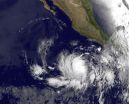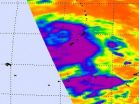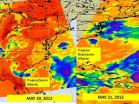(Press-News.org) Richmond, Va. – (May 22, 2012) – Scientists at Virginia Commonwealth University Massey Cancer Center may be one step closer to developing a new therapy for acute myeloid leukemia (AML) after discovering that the targeted agents obatoclax and sorafenib kill leukemia cells much more effectively when combined than when the drugs are administered individually.
Recently published in the journal Blood, the results of a study led by Steven Grant, M.D., Shirley Carter Olsson and Sture Gordon Olsson Chair in Oncology Research, associate director for translational research and program co-leader of Developmental Therapeutics at VCU Massey Cancer Center, and Mohamed Rahmani, Ph.D., associate professor in the Department of Internal Medicine at VCU School of Medicine, showed that the combination of obatoclax and sorafenib synergized to induce a form of cell suicide known as apoptosis and reduced the growth and survival of several types of AML cells while exerting only limited toxicity toward normal, healthy tissues. The results were first obtained in test-tube experiments and were then confirmed by similar findings and extended survival in animal models of AML.
"Prior research suggested that these two drugs may enhance each other's activity as they inhibit complementary survival pathways in leukemia cells," says Grant. "The results of our study are promising. We're looking forward to translating these findings into clinical trials, and we are hopeful we can bring a new, potentially more effective treatment to patients suffering from AML."
Sorafenib is currently approved by the Food and Drug Administration to treat kidney and liver cancers, but recently has been shown to kill a diverse array of malignant cells, including AML cells, particularly those with a specific mutation in a protein known as FLT3. Obatoclax is currently being investigated in clinical trials for various blood cancers.
In AML cells, Grant's team found the combination therapy caused profound cell death and mitochondrial injury, as well as prolonged survival in animal models. Both drugs inhibit the protein Mcl-1, but do so through different mechanisms. Mcl-1 is a protein that has been shown to prevent apoptosis in various cancer cells, and very recently has been shown to play a critical role in the survival of AML cells.
The combination of the two drugs nearly abolished Mcl-1 expression in AML cells, and in doing so unleashed Bax and Bak proteins. Bax and Bak are usually held in check by Mcl-1, and both help initiate apoptosis in cancer cells. Increased levels of Bim were also observed in treated cells. Bim is another pro-apoptotic protein that is often referred to as a "death trigger." Increased levels or activation of all three of these proteins contributed to the pronounced killing of AML cells.
Grant's team also observed protective mechanisms at play in the AML cells. The combination therapy induced autophagy, a process that diverts energy from less critical cellular constituents to enhance survival. Using chloroquine, a drug that suppresses immune responses and is typically used to treat malaria, the researchers were able to inhibit autophagy and increase AML cell death even further.
"When cancer cells are placed under stress, they seek any possible way to remain alive," says Grant. "The combination of these drugs served to block molecular 'escape routes,' leaving the cells no option other than suicide. Thus, it is theoretically possible that a third agent such as chloroquine may enhance the effectiveness of this regimen even further by reducing the cell's ability to induce autophagy."
Moving forward, Grant's team, led by Prithviraj Bose, M.D., assistant professor of internal medicine and hematologist-oncologist at Massey, is proposing a Phase I clinical trial testing this therapy in AML patients. The researchers are working with the involved drug companies, the National Cancer Institute and multiple potential collaborators to initiate the study.
###
In addition to Rahmani, Grant collaborated on this research with Mandy Mayo Aust and Elisa Attkisson from the Department of Internal Medicine at VCU School of Medicine; and Massey researcher David C. Williams, M.D., Ph.D., and Andrea Ferreira-Gonzalez, Ph.D., from the Department of Pathology at VCU School of Medicine.
Funding for this study was provided by Massey as well as by awards CA63753, CA93738, CA100866 and PA50CA130805 from the National Institutes of Health; the Leukemia and Lymphoma Society of America; a Myeloma SPORE award; a Lymphoma SPORE award; and an award from the V Foundation.
About VCU Massey Cancer Center
VCU Massey Cancer Center is one of only 66 National Cancer Institute-designated institutions in the country that leads and shapes America's cancer research efforts. Working with all kinds of cancers, the Center conducts basic, translational and clinical cancer research, provides state-of-the-art treatments and clinical trials, and promotes cancer prevention and education. Since 1974, Massey has served as an internationally recognized center of excellence. It has one of the largest offerings of clinical trials in Virginia and serves patients in Richmond and in four satellite locations. Its 1,000 researchers, clinicians and staff members are dedicated to improving the quality of human life by developing and delivering effective means to prevent, control and ultimately to cure cancer. Visit Massey online at www.massey.vcu.edu or call 877-4-MASSEY for more information.
About VCU and the VCU Medical Center
Virginia Commonwealth University is a major, urban public research university with national and international rankings in sponsored research. Located on two downtown campuses in Richmond, VCU enrolls more than 32,000 students in 211 certificate and degree programs in the arts, sciences and humanities. Sixty-nine of the programs are unique in Virginia, many of them crossing the disciplines of VCU's 13 schools and one college. MCV Hospitals and the health sciences schools of Virginia Commonwealth University compose the VCU Medical Center, one of the nation's leading academic medical centers. For more, see www.vcu.edu.
VCU Massey Cancer Center sees potential in novel leukemia treatment
2012-05-23
ELSE PRESS RELEASES FROM THIS DATE:
Scientists unravel role of fusion gene in prostate cancer
2012-05-23
NEW YORK (May 22, 2012) -- Up to half of all prostate cancer cells have a chromosomal rearrangement that results in a new "fusion" gene and formation of its unique protein -- but no one has known how that alteration promotes cancer growth. Now, Weill Cornell Medical College researchers have found that in these cancer cells, the 3-D architecture of DNA, wrapped up in a little ball known as a chromatin, is warped in such a way that a switch has been thrown on thousands of genes, turning them on or off to promote abnormal, unchecked growth. Researchers also found that new ...
Breast cancer clinical trial tests combo of heat shock protein inhibitor and hormonal therapy
2012-05-23
CAMBRIDGE, Mass. (May 22, 2012) – Pushed to the brink of survival, the hyper-driven cells of a cancerous tumor tap into an ancient system that has helped organisms cope with internal stresses and environmental challenges since life began. As an integral part of this system, heat shock protein 90 (HSP90) has been shown to help malignant cells accommodate the genetic changes and profound disturbances in normal biology that occur in cancers.
Researchers have theorized that inhibiting HSP90 just might render breast cancer cells less likely to escape the challenge posed ...
New study shows how nanotechnology can help detect disease earlier
2012-05-23
LEXINGTON, KY. (May 21, 2012) — A new study led by University of Kentucky researchers shows a new way to precisely detect a single chemical at extremely low concentrations and high contamination.
The study, published online for ACS Nano, was carried out in the laboratory of Peixuan Guo, the William S. Farish Endowed Chair in Nanobiotechnology at the University of Kentucky Markey Cancer Center. The study shows that the phi29 DNA packaging nanomotor connector can be used to sense chemicals with reactive thioesters or maleimide using single channel conduction assays based ...
The older we get, the less we know (cosmologically)
2012-05-23
The universe is a marvelously complex place, filled with galaxies and larger-scale structures that have evolved over its 13.7-billion-year history. Those began as small perturbations of matter that grew over time, like ripples in a pond, as the universe expanded. By observing the large-scale cosmic wrinkles now, we can learn about the initial conditions of the universe. But is now really the best time to look, or would we get better information billions of years into the future - or the past?
New calculations by Harvard theorist Avi Loeb show that the ideal time to study ...
Psychological Science explains uproar over prostate-cancer screenings
2012-05-23
WASHINGTON— The uproar that began last year when the U.S. Preventive Services Task Force stated that doctors should no longer offer regular prostate-cancer tests to healthy men continued this week when the task force released their final report. Overall, they stuck to their guns, stating that a blood test commonly used to screen for prostate cancer, the PSA test, causes more harm than good — it leads men to receive unnecessary, and sometimes even dangerous, treatments.
But many people simply don't believe that the test is ineffective. Even faced with overwhelming evidence, ...
Array of light for early disease detection?
2012-05-23
A special feature in this week's issue of the journal Science highlights protein array technology, touching on research conducted by Joshua LaBaer, director of the Biodesign Institute's Virginia G. Piper Center for Personalized Diagnostics.
With the successful completion of the Human Genome Project, research attention is increasingly focusing on proteins. Versatile products produced from genetic templates, proteins are principle actors in both the maintenance of health and the onset of illness. Protein microarrays are a means of bridging the gap between analysis of the ...
NASA Sees Eastern Pacific's Second Tropical Storm Form
2012-05-23
On May 21, NASA satellites were monitoring Tropical Depression 02E in the eastern Pacific Ocean, and 24 hours later it strengthened into the second tropical storm of the season. Tropical Storm Bud was captured by NOAA's GOES-13 satellite on May 22, and appears to be well-formed.
Tropical Storm Bud isn't going to stop there, however. According to the forecasters at the National Hurricane Center, Bud is expected to become a hurricane because of light to moderate wind shear and warm sea surface temperatures.
On May 22 at 0900 UTC (2 a.m. PDT/5 a.m. EDT), Tropical Storm ...
NASA satellite sees Tropical Storm Sanvu pass Guam, strengthen
2012-05-23
Tropical Depression 03W in the western North Pacific did exactly what forecasters expected over the last twenty-four hours: it became a tropical storm named Sanvu and passed west of Guam on a northwesterly track.
On May 22 at 0900 UTC (5 a.m. EDT), Tropical Storm Sanvu was more than 100 miles west-northwest of Andersen Air Force Base, Guam, and still over 600 nautical miles south of Iwo To, Japan and headed in that direction. Sanvu's center was located near 15.2 North and 141.9. East. It was still churning up rough surf around Guam. Sanvu has maximum sustained winds near ...
Barrow researchers use magic for discoveries
2012-05-23
(Phoenix, AZ May 22, 2012) -- Researchers at Barrow Neurological Institute at St. Joseph's Hospital and Medical Center have unveiled how and why the public perceives some magic tricks in recent studies that could have real-world implications in military tactics, marketing and sports.
Susana Martinez-Conde, PhD, of Barrow's Laboratory of Visual Neuroscience, and Stephen Macknik, PhD, of Barrow's Laboratory of Behavioral Neurophysiology are well known for their research into magic and illusions. Their most recent original research projects, published in Frontiers in Human ...
Alberto now a tropical depression, seen by NASA
2012-05-23
Infrared satellite imagery from NASA's Aqua satellite revealed Alberto weakened from a tropical storm to a tropical depression as it appears more disorganized. At 10:30 a.m. EDT on May 21, Tropical Storm Alberto weakened to a tropical depression, and has maintained that status today, May 22.
As of 5 a.m. EDT on May 22, Alberto's maximum sustained winds were near 35 mph (55 kph) but he is expected to weaken in 24 hours. Alberto was centered about 220 miles south of Cape Hatteras, North Carolina, near 32.0 North and 75.5 West. Alberto was moving to the northeast near 15 ...



